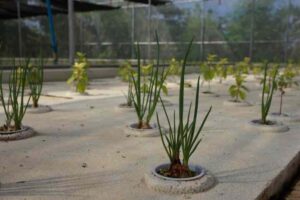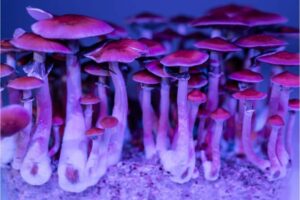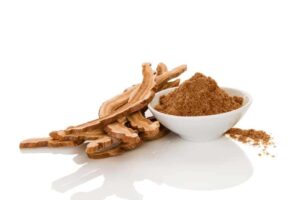
Wilted strawberry plants can be a frustrating sight for any gardener. However, there is still hope for reviving your plants! With a bit of patience and proper care, it is possible to bring them back to health. In this article, we will look at some tips and tricks for how to revive wilted strawberry plants.
We will discuss the importance of proper watering, pruning, and fertilizing, as well as provide some additional strategies for getting your plants back in tip-top shape. With a little effort, you can get your wilted strawberry plants up and running once again.
Identifying Wilting Strawberry Plants
Wilting strawberry plants can be a cause of concern for a gardener, but with the right knowledge they can be identified quickly and easily. Wilting strawberry plants can be caused by a variety of reasons, such as infection, water stress, or nutrient deficiencies.
To determine if your strawberry plants are wilting, examine the foliage for signs of water stress. If the leaves are turning yellow, brown, or black, then they may be suffering from a lack of water. If the leaves are drooping or wilting, then they could be suffering from an infection, such as root rot or blight.
You should also check the roots for signs of nutrient deficiencies, such as discoloration, or if they are soft or slimy. By identifying the cause of wilting, you can take the necessary steps to get your strawberry plants back on track.
Causes of Wilting Strawberry Plants
Strawberry plants are a delightful addition to any garden, but unfortunately, they can be prone to wilting. Wilting is a common problem in strawberry plants and can be caused by many factors.
These include inadequate watering, excessive temperatures, nutrient deficiency, pests, and diseases. Poor drainage or overly saturated soil can lead to over-watering, and this can cause wilting.
Excessive heat can also cause wilting due to the plant’s inability to absorb enough water. Nutrient deficiency can also cause wilting, so make sure the soil is rich in nitrogen, phosphorus and potassium.
Pests and diseases can also cause wilting, as they can cause stress to the plant, which results in wilting.
Lastly, be sure to keep the plant free from weeds, as they can also compete for water and nutrients, causing the plant to wilt. By understanding the causes of wilting in strawberry plants, you can take steps to prevent it from happening, and enjoy a healthy, thriving strawberry garden!
Improving Soil Conditions
Having healthy, balanced soil is essential for any successful garden. From encouraging plant growth and facilitating nutrient uptake to controlling erosion and improving water retention, improving soil conditions is a critical part of gardening.
For any gardener, there are simple steps that can be taken to improve soil conditions. These include adding organic matter, improving drainage, and improving soil aeration.
Additionally, the use of soil amendments, such as compost or manure, can help increase the soil’s fertility, as well as its ability to retain nutrients and water. With a little attention to soil conditions, gardening can become a rewarding experience.
Watering and mulching is an essential part of any garden maintenance routine. Watering helps to keep plants healthy and hydrated, while mulching helps to retain moisture, suppress weeds, and insulate soil. With regular watering and mulching, your garden will be filled with lush, vibrant plants and a healthy ecosystem.
Watering should be done on a regular basis, depending on the needs of the particular plants in your garden. Mulching helps to keep moisture in the soil and can be applied around the base of plants to protect them from the heat of the sun.
It also helps to reduce weeds by blocking their access to sunlight. By combining both watering and mulching, you can create a beautiful, lush garden that is sure to be the envy of your neighborhood.
Fertilizing & Pruning
The section of Fertilizing & Pruning provides important information about how to keep your garden in top condition. With regular fertilizing and pruning, you can ensure your plants get the essential nutrients they need to grow healthy and strong.
Fertilization:
- Check Soil pH: Strawberry plants prefer slightly acidic soil. The pH should ideally be between 5.5 and 6.5. If it’s higher or lower, the plant may not be able to absorb nutrients efficiently. You can get a soil test kit to check the pH level.
- Choose the Right Fertilizer: For strawberry plants, a balanced fertilizer (10-10-10) can be used. It’s also beneficial to use a fertilizer high in phosphorus (the middle number) to encourage fruit production.
- Apply Fertilizer: In early spring, apply fertilizer around the base of your strawberry plants, making sure not to get any on the leaves. Follow the package instructions for the correct amount.
- Watering: After applying the fertilizer, water your strawberry plants deeply. This will help the nutrients to penetrate into the root zone.
Pruning:
- Inspect the Plant: Before pruning, inspect your strawberry plants to identify dead or dying leaves, stems, or fruit.
- Prune Dead or Diseased Parts: Using a sharp pair of garden scissors, carefully remove any dead or diseased parts of the plant.
- Trim Runners: Strawberry plants produce runners, which are long, slender stems growing out from the main plant. Too many runners can drain energy from the plant. Trim the runners, leaving one or two per plant to grow new plants if needed.
- Prune for Growth: Pruning in late summer after harvesting encourages the plant to direct its energy towards root growth rather than foliage or fruit. This helps it prepare for the next season.
- Dispose of Debris: Ensure to clean up and dispose of all pruned parts. They could potentially harbor disease or pests.
Remember, strawberries need full sun, well-draining soil, and consistent watering in addition to proper fertilization and pruning. Good luck with your strawberry plants!
Replanting & Troubleshooting
In order to keep your garden thriving, it is important to know the basics of replanting and troubleshooting. Replanting refers to the practice of replacing plants that have died or become unhealthy. This can be due to a variety of reasons, such as pests, disease, climate, or improper care.
Troubleshooting, on the other hand, is the process of diagnosing and addressing any issues that have arisen in the garden. This could include identifying and controlling pests, dealing with soil issues, determining which plants will thrive in certain climates, or any other number of problems gardeners may encounter.
Knowing how to replant and troubleshoot your garden is essential to keeping it healthy and beautiful!
FAQs About the How To Revive Wilted Strawberry Plants
What are the signs of a wilting strawberry plant?
Answer: Wilting strawberry plants typically show signs of yellowing leaves, stunted growth, and decreased production of fruit.
What can I do to revive a wilting strawberry plant?
Answer: You can revive a wilting strawberry plant by providing it with adequate sunlight and water, making sure the soil is well-drained, and applying a balanced fertilizer.
How often should I water a wilting strawberry plant?
Answer: You should water a wilting strawberry plant when the top inch of soil is dry. The amount of water you provide should be determined based on the size of the plant and weather conditions.
Conclusion
In conclusion, reviving wilted strawberry plants can be a difficult and time-consuming process, but with patience and the right knowledge, it can be done. The first step is to properly diagnose the problem, which may include examining the soil, checking for pests, or determining if the plant was watered too much or too little. Once the issue is identified, it is important to take the appropriate steps to address it. This can involve amending the soil, making sure the plant is receiving the right amount of sunlight and water, or applying any necessary insecticides. With the right care and attention, it is possible to revive wilted strawberry plants.







